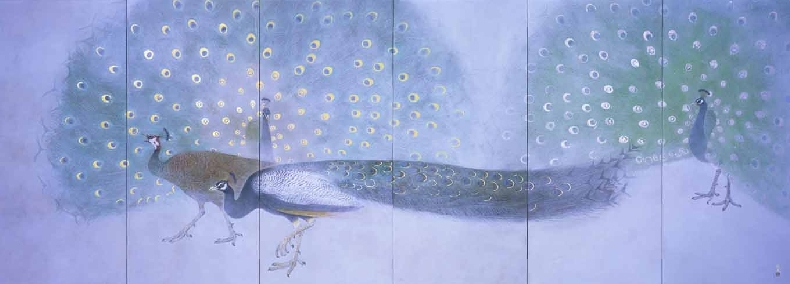“King” 182 x 498 Folding Screen
The 87th The Japan Art Institute Exhibition
The Minister of Education, Culture, Sports, Science, and Technology Award
Imai Museum of Art Collection

I had been to India several times for my research, but I did not realize how hard the environment and my life there was until after I started living there with four family members. However, as our house was facing a large park, I could see dogs, wild pigs, squirrels, and donkeys carrying things, but also camels passing by, eating leaves from our garden.
Numerous chickens and birds were flying around. Peacocks would land on the roof of our house with a clatter and then cry out loud.
The peaceful coexistence of people and animals was interesting to see. I was especially intrigued by one loving pair of elegant peacocks. They would rest for long time under a tree when the sunshine was strong. As a nice breeze would shake their tails, they would begin to move by stretching their wings out wide. The divine view of them flying in the morning sun stuck in my mind.
One of the reason I named this work “King” was that the peacock is the biggest and most beautiful bird. However, I was also thinking about the following story, the sad love story of the Taj Mahal. The monument was built by a King, who was mourning of the death of his wife.
However, building it took so much time and money that the King was imprisoned by his son who revolted against him.
When I was working on a piece called “The Taj Mahal Under The Starry Night,” I imagined that the couple was reborn as a pair of peacocks and appeared in the garden side by side.
The peacock has an exotic image, but it also appears often in traditional Japanese paintings. Elegance, poise, and a proud existence. To portray them, I visited Shozu Island and Izu for research several times. I painted it on six pieces of a folding screen with the intention of it being a new contemporary still life painting.
 Prev
Prev